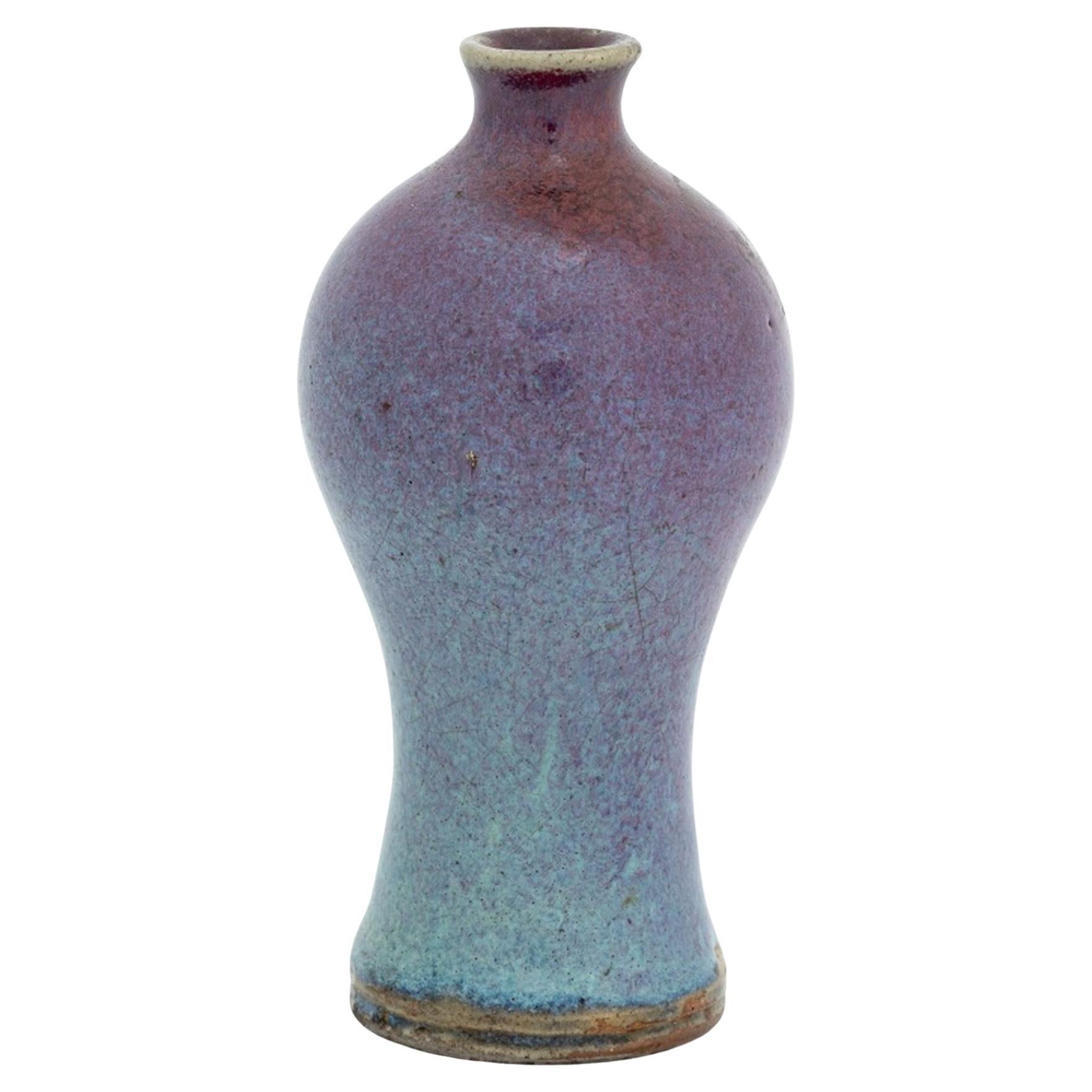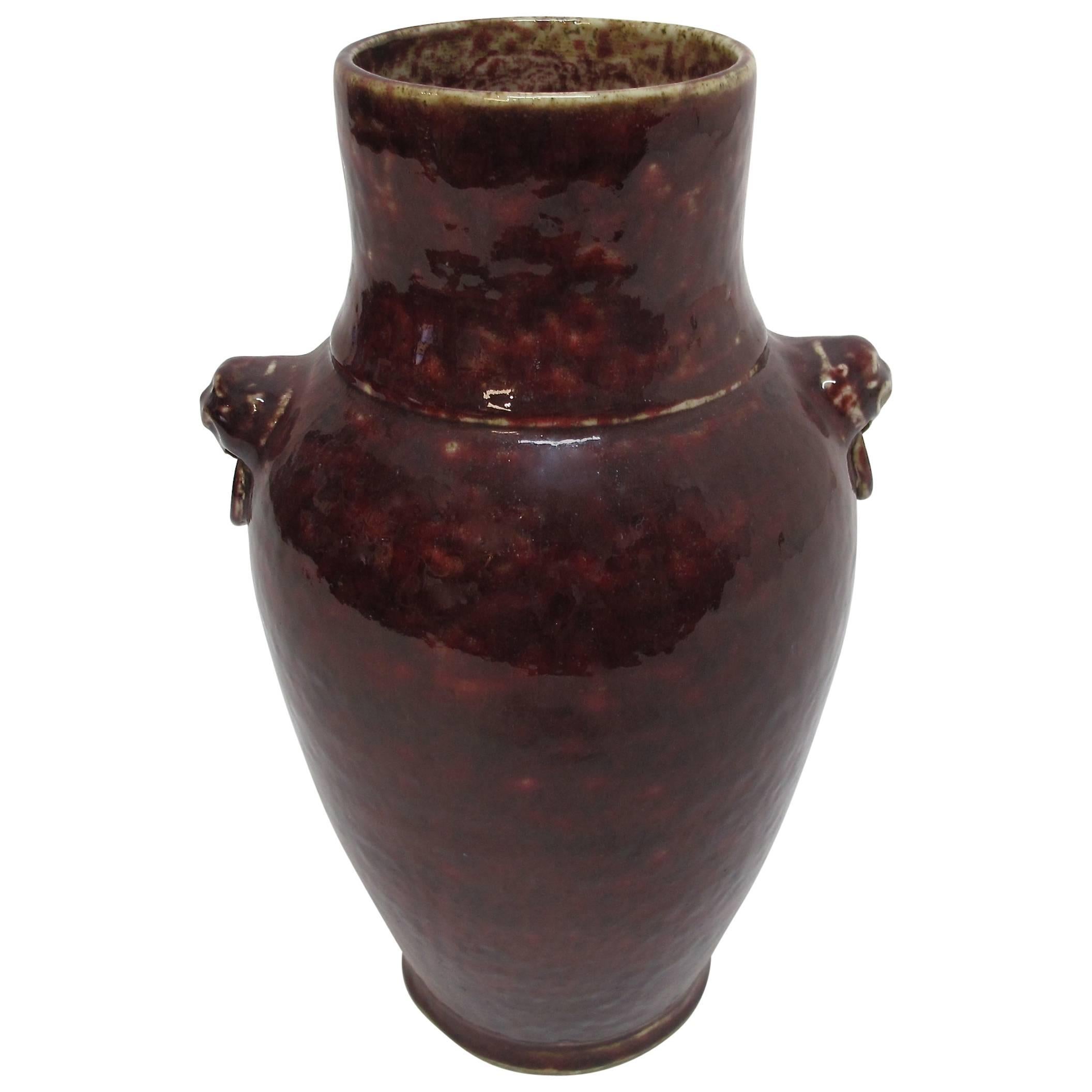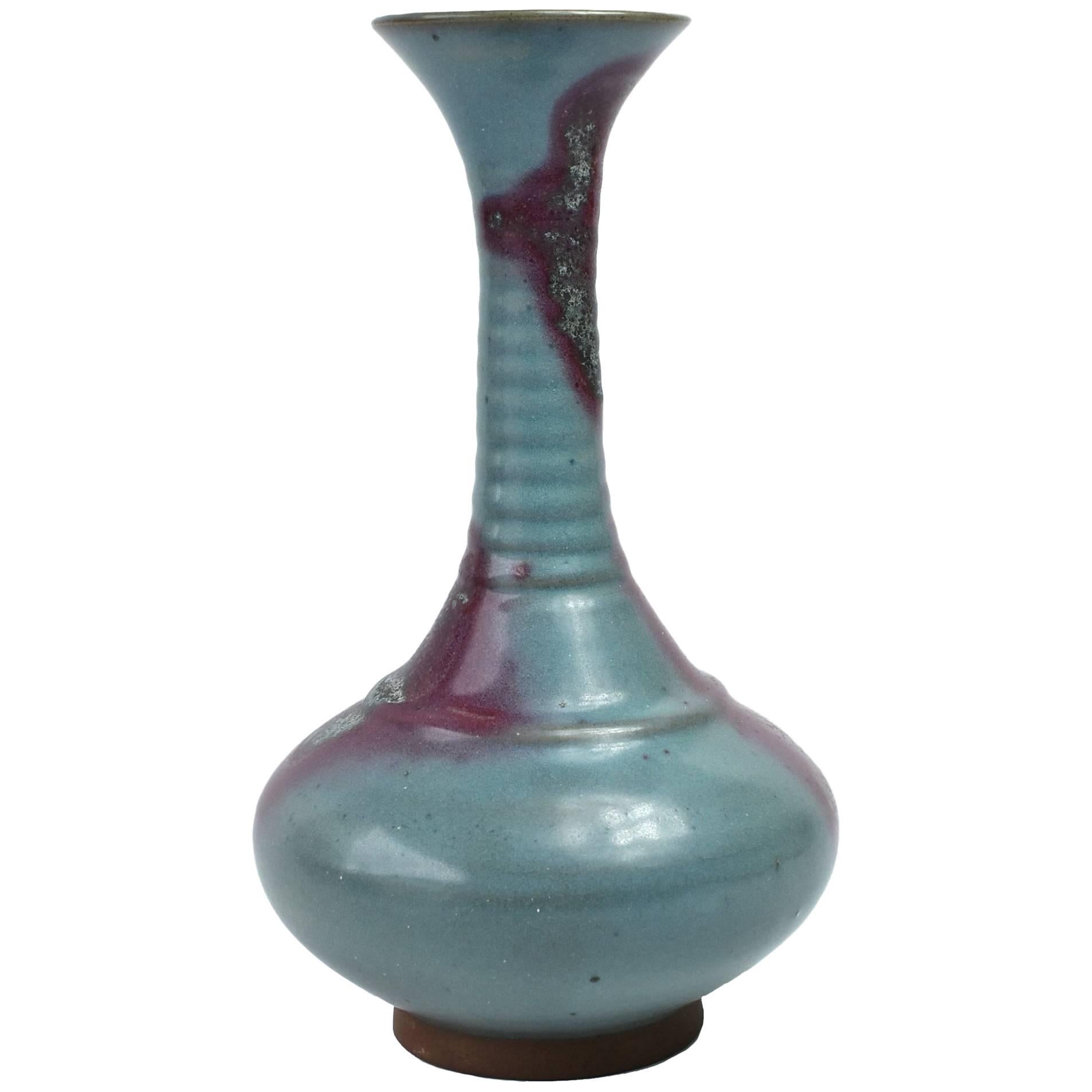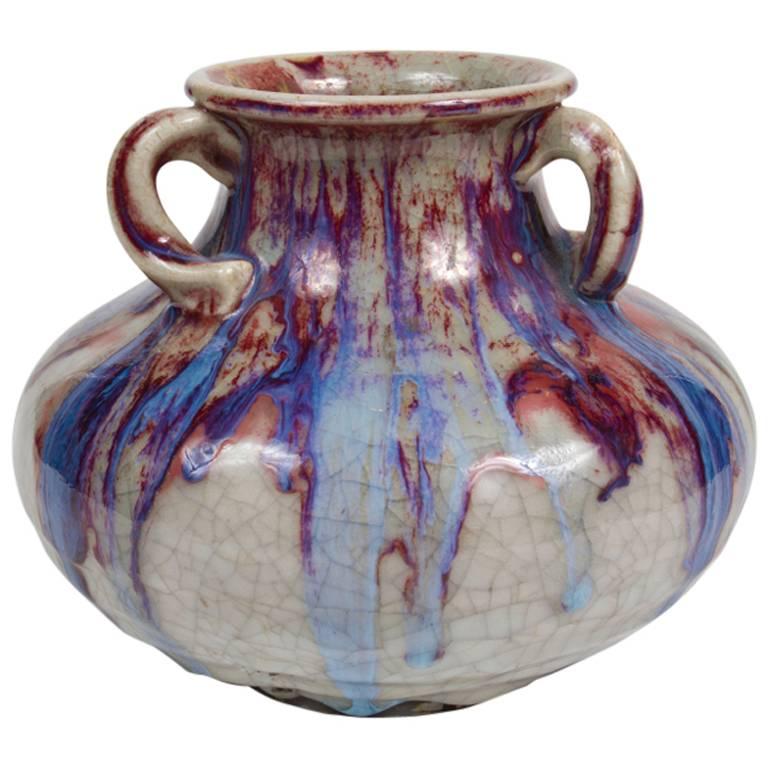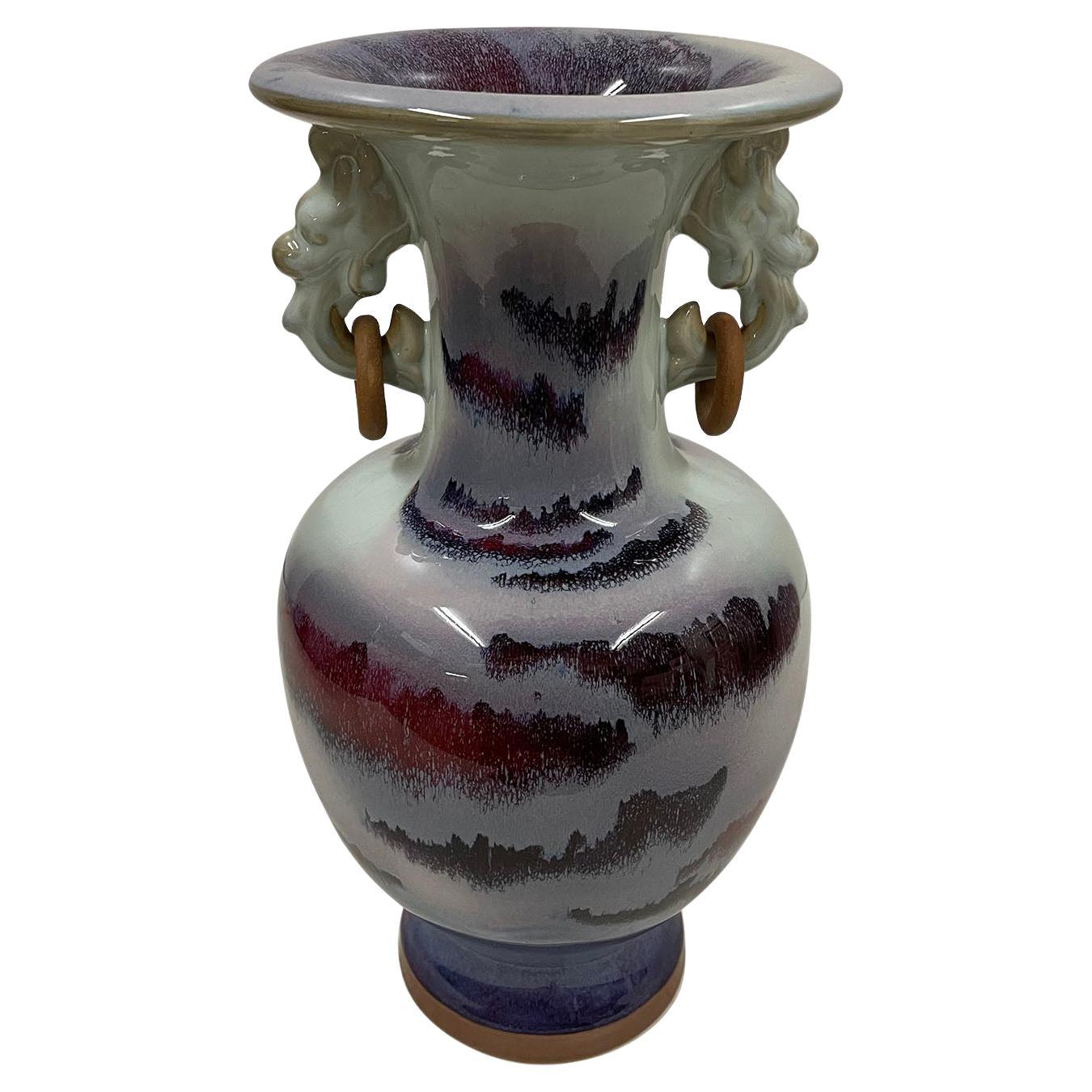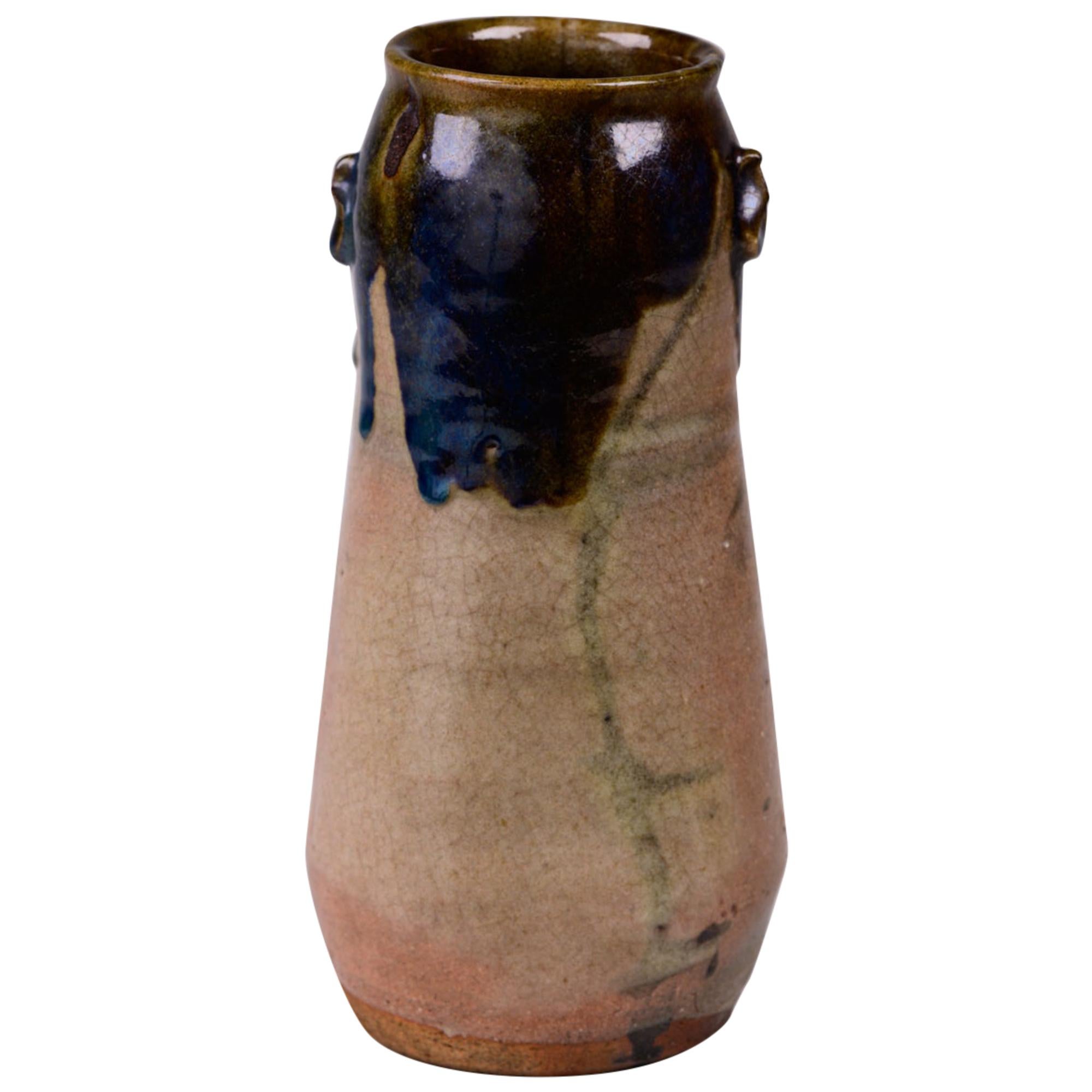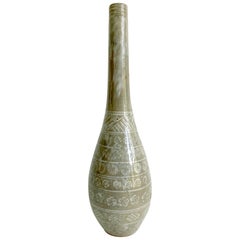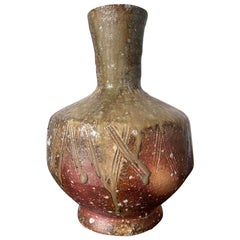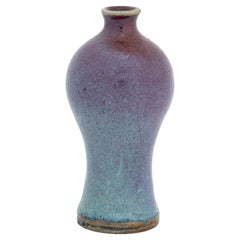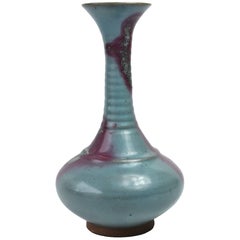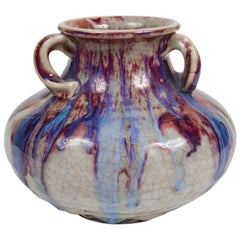Items Similar to Asian Flambe Studio Pottery Vase
Want more images or videos?
Request additional images or videos from the seller
1 of 9
Asian Flambe Studio Pottery Vase
$1,800
£1,352.64
€1,568.75
CA$2,526.93
A$2,804.01
CHF 1,479.04
MX$34,230.93
NOK 18,712.81
SEK 17,526.06
DKK 11,707.30
About the Item
A garlic bottle vase in an archaic Chinese form, but likely Japanese in origin. Several circumventing grooves however, suggest a more modern age. It was done in a brilliant purple glaze over a robin egg blue background glaze. The bubbling and bursting effects during the firing renders the surface an artistic spotting effect. The color pallet recalls the Classic Jun Yao in China yet the glaze effect appears more related to JianYao. Upon closer inspection, the glaze was likely applied in a dipping method, as the slight dripping can be seen on the top half of the vase. Not signed but we think it was made toward the end of 19th century.
- Dimensions:Height: 2.76 in (7 cm)Diameter: 1.68 in (4.25 cm)
- Style:Japonisme (Of the Period)
- Materials and Techniques:
- Place of Origin:
- Period:
- Date of Manufacture:Late 19th-Early 20th Century
- Condition:Wear consistent with age and use. Minor wear only.
- Seller Location:Atlanta, GA
- Reference Number:1stDibs: LU945014983112
About the Seller
4.9
Platinum Seller
Premium sellers with a 4.7+ rating and 24-hour response times
Established in 2006
1stDibs seller since 2010
565 sales on 1stDibs
Typical response time: <1 hour
- ShippingRetrieving quote...Shipping from: Atlanta, GA
- Return Policy
Authenticity Guarantee
In the unlikely event there’s an issue with an item’s authenticity, contact us within 1 year for a full refund. DetailsMoney-Back Guarantee
If your item is not as described, is damaged in transit, or does not arrive, contact us within 7 days for a full refund. Details24-Hour Cancellation
You have a 24-hour grace period in which to reconsider your purchase, with no questions asked.Vetted Professional Sellers
Our world-class sellers must adhere to strict standards for service and quality, maintaining the integrity of our listings.Price-Match Guarantee
If you find that a seller listed the same item for a lower price elsewhere, we’ll match it.Trusted Global Delivery
Our best-in-class carrier network provides specialized shipping options worldwide, including custom delivery.More From This Seller
View AllJapanese Mishima Ceramic Vase Meiji Period
Located in Atlanta, GA
A Japanese long neck slender ceramic vase in the style of Mishima, circa 19th century, Meiji period. Mishima pottery was originally imported from three islands in Taiwan and then fro...
Category
Antique 19th Century Japanese Japonisme Ceramics
Materials
Ceramic
Modern Japanese Ceramic Shigaraki Ikebana Vase Takahashi Shunsai
Located in Atlanta, GA
A tall ceramic vase made in the tradition of Shigaraki ware by Japanese potter Takahashi Shunsai (1927-2011), the fourth heir of the famed Rakusai lineage of potters. The vase is heavily potted in the reddish sandy Shigaraki clay. It has a Classic vase form made for Ikebana display. The surface is thickly draped with natural ash glaze that deposited onto the body during the firing process in the kiln. It also features decoration of carved lines. Nuggets of feldspar were incorporated in the clay and exposed onto the surface as crystal like jewels. Substantial and archaic looking, the vase also has a strong modern appeal due to its Mingei styling. It was signed on the base with a pressed seal Shunsai as shown. The vase comes with its original wood storage box (tomobako) with bears the title and signature in Kanji and a seal. It also retains a paperwork noting the artist's biography and practice philosophy in Japanese.
Born in Shigaraki, Shunsai was the second son of renowned potter Takahashi Rakusai...
Category
1990s Japanese Modern Ceramics
Materials
Ceramic
Japanese Ceramic Vase Mingei Style Hamada Shoji
By Hamada Shoji
Located in Atlanta, GA
A heavily potted stoneware vase in cylindrical form, decorated with abstract strokes in iron rust glaze (known as Persimmon Glaze in Japanese) on a black glazed background. The pattern suggests autumn grasses, and it was applied with free hands. The vase is attributed to Japanese potter Hamada Shoji...
Category
Late 20th Century Japanese Arts and Crafts Ceramics
Materials
Ceramic
Korean Glazed Ceramic Vase Buncheong Ware Joseon Dynasty
Located in Atlanta, GA
A small antique Korean Buncheong stoneware vase from early Joseon Dynasty circa 16th century. The vase is of a classic pear form with a waisted neck, a flared mouth and a ringed base...
Category
Antique 16th Century Korean Other Ceramics
Materials
Ceramic
Japanese Ceramic Sake Bottle Chosen Karatsu Ware
Located in Atlanta, GA
The long neck bottle of classic form was heavily potted with coarse clay with high iron content. The flask, circa 18th century Edo period, was purposed for sake storage but also substituted as a flower vase during tea ceremony. The surface is covered in glossy black glaze and contrasts strikingly with white ash glaze around the shoulder. The white, fired with straw, displays a splashing feather effect and fine crackles, blending in with the black artistically. This type of Karatsu ware...
Category
Antique 18th Century Japanese Japonisme Ceramics
Materials
Ceramic
Korean Ceramic Storage Jar Joseon Dynasty
Located in Atlanta, GA
A Korean ceramic storage jar circa 18th century of Joseon Dynasty. The jar is of a characteristic form with a bulbous upper body that tappers with a gra...
Category
Antique 18th Century Korean Other Ceramics
Materials
Ceramic
You May Also Like
Chinese Flambe Glazed Meiping Vase
Located in Astoria, NY
Chinese Flambe Glazed Diminutive Meiping Vase. 4.5" H x 2" Diameter. Provenance: From a 35 East 75th Street Estate.
Category
Antique 19th Century Chinese Qing Ceramics
Materials
Ceramic
Early 19th Century Chinese Flambe Vase
Located in San Francisco, CA
Chinese vase with beautiful rich flame glaze, having foo dog ring handles on the shoulders, China, 19th century.
Category
Antique 19th Century Chinese Ceramics
Materials
Porcelain
Jun Ware Chinese Porcelain Vase, Tang Dynasty Style, Vase 3
Located in Somis, CA
A splendid Jun ware porcelain Yu Tang Chun vase. Jun ware, is one of the most important kilns in China. Originated in Tang dynasty, Jun kiln produces the most...
Category
20th Century Chinese Tang Ceramics
Materials
Porcelain
Stylish Japanese "Flambé" Ceramic Vase
Located in Montreal, QC
Studio pottery Japanese “Flambé” glazed ceramic vase.
Category
Vintage 1970s Japanese Ceramics
Materials
Ceramic
Mid 20th-Century Chinese Jun Ware Fambe Glaze Landscaping Porcelain Vase
Located in Pomona, CA
Look at this magnificent Chinese Jun porcelain vase. It was hand made and hand paint from famous Chinese Jun Porcelain. It shows the natural fambe glaze ...
Category
Mid-20th Century Chinese Chinese Export Vases
Materials
Porcelain
$513 Sale Price
25% Off
Large, Beautiful Country-Ware Vase
Located in Hudson, NY
Large, beautiful country-ware vase. Possibly Oribe vase with beautiful blue-green drip over-glaze and other nice glazing techniques. Small "ears" on the side. Taisho period handmade ...
Category
Early 20th Century Japanese Taisho Ceramics
Materials
Ceramic
More Ways To Browse
Studio Pottery Signed
Japanese Glazed Pottery
Blue Pottery Signed
Chinese Art Pottery
Antique Japanese Pottery
Asian Ceramic Vases
Blue Studio Pottery
Kyoto Furniture
Signed Asian Vases
Chinese Blue Pottery
19th Century Chinese Pottery
Signed Japanese Pottery
Japanese Studio Pottery
Flambe Glaze
Flambe Glazed Vase
Chinese Studio Pottery
Antique Pottery Bottle
Antique Ceramic Bottles
